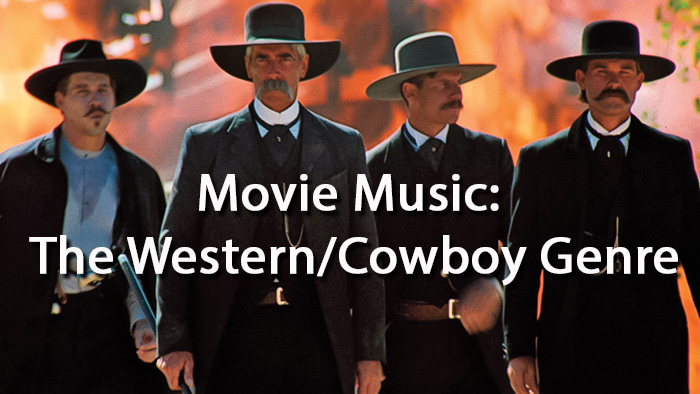
The consensus amongst historians is that the western/cowboy period in the United States was but a short 30 years spanning 1865 to 1895. The former year marked the end of the US Civil War which cleared the way for economic re-pointing and expansion of US settlement westward (there were half the current number of states at the end of that war).
This expansion was greatly spurred by ranchers who ran cattle to feed the population back east. And there arose the need for cowboys who as their name suggests tended the cattle, maintained the ranches and herded stock to sale yards. Stories from the west emanated from real and imagined (probably stories with kernels of truth much exaggerated) to do with the hardship of wagon training westward, setting up a home and livelihood in a new land, of clashes with each other over land ownership, confrontations between the law and outlaws, and of course, more importantly, clashes with the native First Nation peoples who took exception to the settlers taking over their homeland and its resources. Add to this background, the typical human failings of avarice, jealousy and greed but also human virtues of heroism, altruism, and sacrifice for the greater good, you have a rich mine to tap for stories to make into western/cowboy motion pictures (movies).
It is thought that the end cowboy era started with the winter of 1886/87 when the severe winter killed off thousands of cattle. This led to a change in ranching management where open-trail cowboys were no longer needed. Open ranches gave way to private ranches which could be blocked off by the use of the newly invented barbed wire. Open trail cowboys quickly became ranch hands.
What appears on visually screen is calculated by the movie director to elicit an empathetic response from the movie audience. Because the human emotion is much influenced by music, movies had an element of mood music even during the silent movie era. This was typically achieved by live piano, organ or even orchestral music being played to accentuate movie scenes where required. When sound took over silent movies, the music score to a movie became important.
The genre of music of the western/cowboy movie is typically very distinctive. It was made so until the advent of the "spaghetti westerns" in the early 60s, by a rather forward, brass, percussion and string sections. The beat usually evokes the pacing of horses (galloping in action scenes). I share with you some salient examples from this genre of music from the years when I started to notice the music score in movies.
The Magnificent Seven (1960)
Elmer Bernstein
Erich Kunzel and the Cincinnati Pops Orchestra
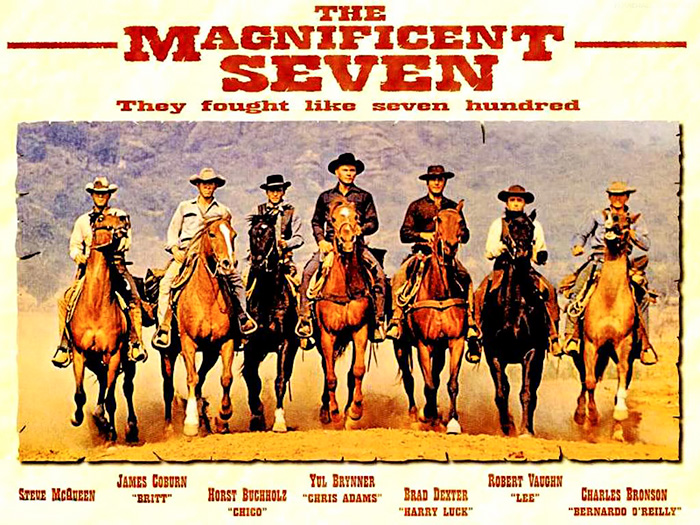
https://www.youtube.com/watch?v=4_uF29CKVV4
Elmer Bernstein was successful in his trade and scored for
many movies
including westerns. However, he is forever remembered
for his soaring big theme for the "Magnificent Seven". In this
movie adaptation of Kurosawa Akira's "Seven Samurai", poor
Mexican villagers convince a band of seven gunslingers to
protect them against a bunch of baddies.
The video clip linked above is for the Film Symphony Orchestra
of Barcelona playing the main theme in 2014. However, the version which I like
best because of the music arrangement and quality of recording (Telarc
International Corp., an audiophile company) is that of the
Cincinnati Pops Orchestra conducted by Erich Kunzel (2006).
In this arrangement, the music is suite-like with a calm part
which evokes Mexico before rejoining the stirring main theme.
Even at YouTube-attenuated audio quality, in this audiophile
recording, with a good speaker (at least listen through
headphones), you can hear the deep thump of
the bass drum. Magnificent!
In 2005, the score for "The Magnificent Seven" was ranked 8th in
the American Film Institute's List of Top 25 American Film
Scores (Number 1 being "Star Wars").
This music was noticed by the makers of Marlboro cigarettes who chose to use it to back their "Marlboro Man" (a cowboy) TV advertisements (until 1971 when cigarette ads were banned in the US):
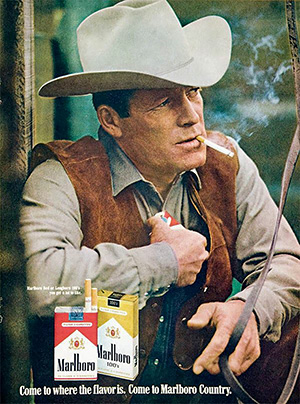
Different men were used
as the rugged cowboy in the Marlboro Man ads. It is said that at
least five of them were to die of smoking-related diseases.
The Good, the Bad and the Ugly (1967 US release)
Ennio Morricone
The Hugo Montenegro recording of this movie theme peaked at No.
2 on the US Billboard Hot 100 in 1968 (held off No. 1 by
"Mrs. Robinson" from the movie "The Graduate"). However, it was
a 1968 No. 1 on the UK Singles Chart.
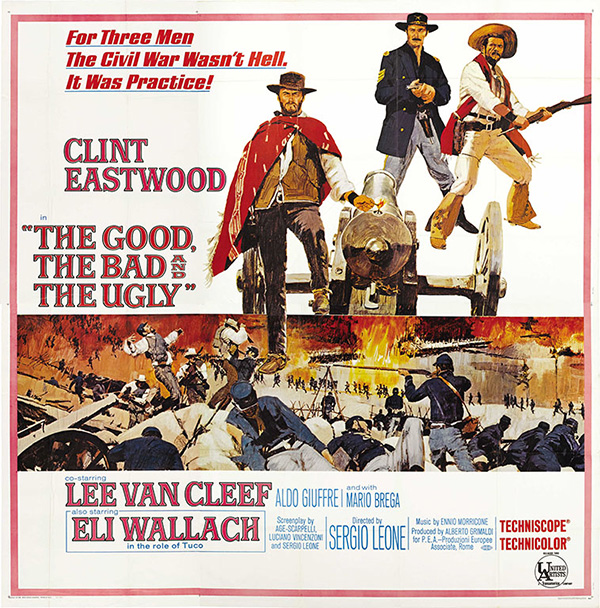
https://www.youtube.com/watch?v=kHfbzoq-grE
With the arrival of a new genre of westerns collectively
called "spaghetti westerns" because of where the producer film
studios and financing were from (Italy), I saw a distinct (and
unwelcome) change in the setting and faces in these so-called
cowboy movies. The scenery was different and even though arid
dry places were used they never matched the grandeur of the backdrop conferred by
the American west because the "spaghettis" were often shot in
Spain. Apart from the main stars (minor Hollywood entities)
whose features were familiar (Irish-Scots stock or northern
European at any rate), now one would see distinctly darker
features of the Southern European or Latin stock. Costumes were
different because ponchos seemed to be what your average cowhand
or gunslinger would wear. And then that other big difference -
the music. No one exemplifies music of the "spaghetti western"
more than
Ennio Morricone.
Morricone's music first came to notice with Sergio Leone's "A Fistful of Dollars" (1964) as did attention on the actor Clint Eastwood who played the main character (the "Man with no name"). To my mind, the music was anachronistic and used voice as had not been noticeable before. Clearly, electric guitars were only invented long after the days of the wild west and yet, this instrument was forefront in Morricone's score. However, I have chosen his score from another movie as the exemplar of his work.
"The Good, the bad and the Ugly" was the third in the "Dollars" trilogy, all of which starred Clint Eastwood. I chose the main theme from this movie as an exemplar of spaghetti western music because it is very well-known, and can still be found in radio station playlists. The score was also a hit because the soundtrack album peaked at No. 4 on the album chart in 1968. Hugo Montenegro's rendition of the main theme peaked at No. 2 on the US Billboard Pop Single chart also in 1968. It is the Montenegro version that I have linked above for you because it was the one which played most on the airwaves and one which you are likely familiar with.
In the sense that movies can affect us through memory-shaping, maybe even character-influencing and sometimes tug at our social conscience, the westerns of Leone gave rise to Clint Eastwood as a star and the subsequent clutch of movies which starred him or were directed by him - who of the seventies and eighties has not seen a Clint Eastwood film? Just for an example, consider the first "Dirty Harry" movie which posed the balance between rule of law and the use of force in the name of justice. This is especially relevant given the police events in US cities in recent years.
Butch
Cassidy and the Sundance Kid (1969)
Burt Bacharach
The love theme from this movie "Raindrops Keep Falling on
my Head" (Burt Bacharach/Hal David) peaked on the
US Billboard Hot 100 at No. 1 in 1970
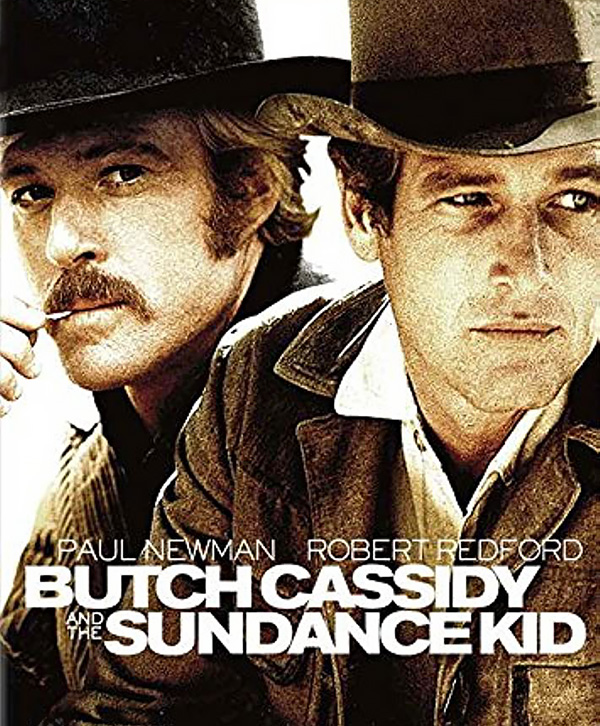
https://www.youtube.com/watch?v=_VyA2f6hGW4
I had previously written about this song elsewhere but I include it here for completeness of my western movie set. About "Raindrops Keep Falling On My Head", I had written:
"From the western movie "Butch Cassidy and the Sundance Kid" (1969) set in 1899. To me, before this, movie music was always in keeping with the era in which the movie was set. Indeed, it was used to set mood. Along came movies like these two which had anachronistic music in the soundtrack. It took some getting used to. Even co-star Robert Redford wondered "... I was highly critical: How did the song fit with the film?" (McEvoy, 2023). But it now seems normal and yet another tool in movie making for mood setting.
The song was written by the late great
Burt Bacharach (1928 - 2023) and one of his
best lyricists, Hal David. However, it was the Director of the
movie,
George Roy Hill, who decided to
include the song against the doubts of some people including
cast members like Redford (he remarked that the scene had no
rain in it, which is true). It went on to win the Oscar for the
Best Original Song in 1970. "Raindrops Keep Falling On My Head"
was inducted into the National Academy of Recording Arts and
Sciences Grammy Hall of Fame in 2014."
The leading stars, Paul
Newman and Robert Redford went on to make another successful "duo"
movie, "The Sting" (1973) again directed by George Roy Hill. It
won the 1974 Oscars for Best Picture, Best Director, Best
Writing, Best Art Direction, Best Costume Design, Best Film
Editing, and Best Music including Marvin Hamlisch's re-working
of Scott Joplin's ragtime tune "The
Entertainer"
Whereas Sergio Leone's
spaghetti westerns were anachronistic in choice for example, of
the electric guitar, Bacharach's soundtrack score was
anachronistic in music style - it was very modern for an movie
set in a past century. It was not the first time that Bacharach
had been used in such a manner. I had referred (see above) to
John Barry defining the classic music style for the Bond movies. Along came Bacharach with an
iconoclastic score for "Casino Royale" (1967) (a spoof, intended
or otherwise) of the Bond movies. I think all one could say
about that effort is that people did laugh but at the
film-makers rather than along with the parody. Hear how
different the title track
(performed by Herb Alpert & the Tijuana Brass) for that
movie sounds compared to Eon Studios' Bond productions (say "Thunderball"
[1965]).
But, there is a context: In the preceding years, Herb Alpert & the
Tijuana Brass had a string of
successful recordings and so
sooner or later the band would be used in movies. Bacharach/David
and Herb Alpert went on the following year to score a major hit
with "This
Guy's In love With You" (US Billboard Hot 100 No. 1
in 1968). How many guys out there have sung this tune to their
loved one since then I wonder.
Themes from
"Silverado" (1985)
Bruce Broughton
Erich Kunzel and the Cincinnati Pops Orchestra
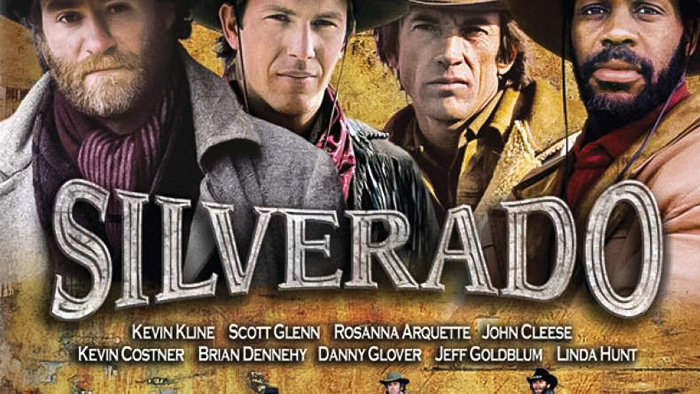
Several plotlines are strung at the beginning of the movie. They converge at some point in the movie to go down the cliche of good against evil but in a rewarding and enjoyable (my assessment) way (comeuppance is delivered). The casting resulted in believable characters (Scott Glenn; Kevin Kline; Kevin Costner [see below]; Danny Glover) with whom you empathized and cared to know what would happen next. You got to know the character of one of the main players, Paden when you learn that he had gone to jail after not riding away after a bank robbery in order that he could save an injured dog. Logos, ethos and pathos are found in this movie.
The main title track
portends something big awaits in the wide expanse of the story's
location (New Mexico). You are likely to reach for and tie a
kerchief on your face to keep trail dust out by the end of the score. Bruce
Broughton's "Silverado" score was nominated for an Oscar in
1985 but lost to John Barry's "Out of Africa" score (see
below). It would have been a tough year when a fellow Oscar
nominee was John Barry.
The video linked above has the composer Broughton conducting the
21st Century Symphony Orchestra in Vienna. For an audiophile
recording of the main theme by the Cincinnati Pops Orchestra
conducted by Erich Kunzel, check this
link.
Dances
With Wolves (1990)
John Barry
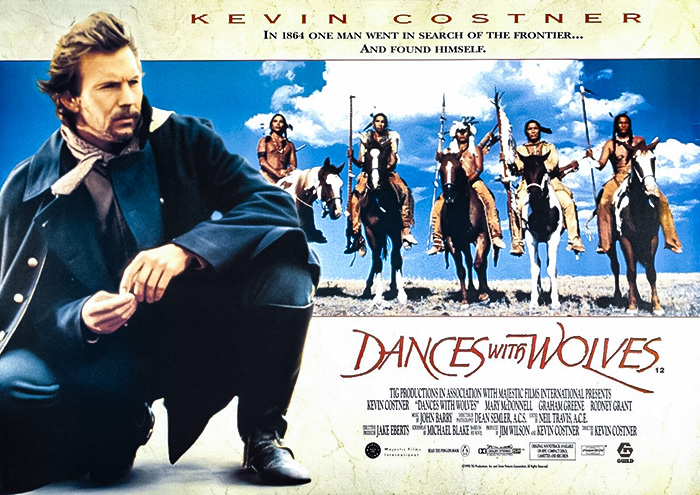
https://www.youtube.com/watch?v=QEZnE2UjY6E
The piece from the soundtrack album which is linked above, is the John Dunbar (the main character played by Kevin Costner who also directed the movie) theme. It recurs through out the movie.
This movie does not stereotype
the American west and the characters in stories which arise from
there. And so, having John Barry (1933 - 2011) to write the score for the
movie was seemingly appropriate. John Barry came out of the 60s
being famed for his scores for the first clutch of James Bond
movies (my favourite is the soundtrack from the unfairly
underrated "On Her Majesty's Secret Service" - here is the
main theme and the
love theme). His music is big
and engrossing. Barry uses strings and brass to produce his
signature sound. Highly recognisable. He uses strings, horns and voice
to heighten our participation and soar with Karen and Denys in
"Out of Africa" (1985) ("Soaring
over Kenya").
The music is poignant for a love that was not meant to be
(between Karen and Denys).
Barry was a peerless movie score composer.
"Dances with Wolves" won 1991 Oscars for Best Picture (Kevin Costner/Jim Wilson, Producers), Best Director (Kevin Costner), Best Actor (Kevin Costner), Best Supporting Actor, Best Supporting Actress, Best Adapted Screen Play, Best Art Direction, Best Cinematography, Best Costume Design, Best Film Editing, Best Original Score (John Barry), and Best Sound. Just about as clean a sweep as one can get at the Oscars.
Another western movie with a sympathetic view of the American
First Nation peoples is a much earlier one called "Little Big
Man" (1970). Like John Dunbar, Jack Crabb
lived with the Red Indian and
grew to respect and love them as a people.
A Million Ways
to Die in the West
(2014)
Joel
McNeely
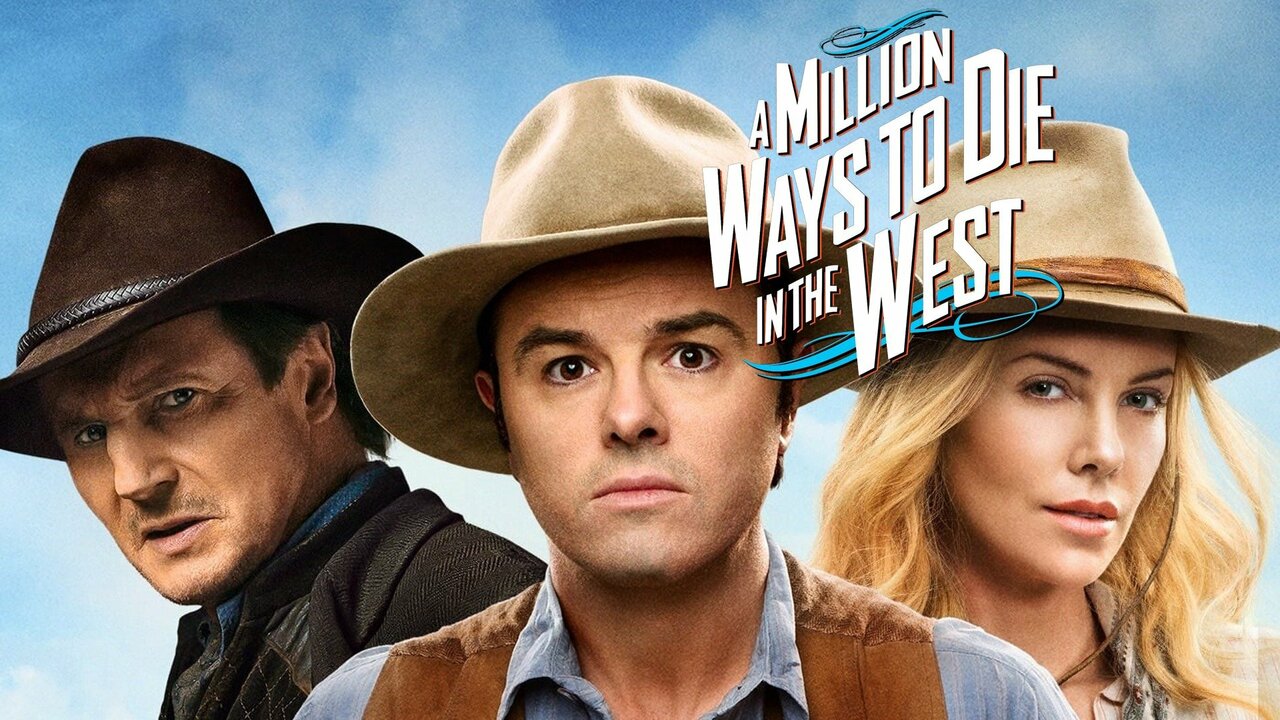
https://www.youtube.com/watch?v=Nzzj2_7qMsY
This is the rather improbable story of the adventures of a
hapless sheep farmer, Albert (Seth MacFarlane) who has to face
up to not only the dapper but obnoxious storekeeper (Foy; Neal
Patrick Harris) who won over his materialistic ex-girlfriend
(Louise; Amanda Seyfried), but also the deadly, dastardly leader (Clinch; Liam Neeson)
of a bunch of killers, in order to be with his true love (Anna; Charlize
Theron). Along the way, Albert has his friend Edward (Giovanni
Ribisi) and his prostitute girlfriend (Ruth; Sarah Silverman) who have
an out-of-era modern relationship providing emotional support.
It's a wild west story with a contemporary dialogue which makes
the story-telling quirky in an amusing way.
Joel McNeely (1959 - ) wrote the music score. His opus gives credence to many a view including mine that music for western movies has a typical sound. McNeely is not of the old school generation who wrote scores for the classic westerns of the 50s and 60s. His work in this movie is the only one of his portfolio scored for a western. And yet, listen to the main title track and you will know that the music is for a western movie. Cue in fanfare blaring brass, stirring strings, interwoven folk tune motifs, and a galloping beat by the percussion section.
Happy trails and yippyaiyeah!